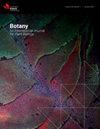了解Wollemi pine(Wollemia nobilis)植物生长调控和进化的非靶向和靶向代谢组学
IF 1.3
4区 生物学
Q3 PLANT SCIENCES
引用次数: 0
摘要
Wollemi Pine(Wollemia nobilis(Jones,Hill,Allen))是一种活化石,直到1994年在澳大利亚发现为止,只有通过化石记录才能知道。Wollemi Pine与诺福克岛松(Araucaria heterophylla(Salisb.)Franco)亲缘关系密切,是研究代谢进化的一个有趣的系统。我们采用基于非靶向液相色谱-质谱(LC-MS)的代谢组学、化学计学、途径分析和我们新的植物生长调节剂(PGR)推定鉴定工具(HormonomicsDB)来探索这两个物种的代谢组。我们鉴定了PGR偶联物,并发现细胞分裂素、玉米素和油菜素甾体途径在Wollemi Pine组织中过度表达,表明这些PGR在其生存中发挥着重要作用。褪黑激素是一种古老的、与压力相关的PGR,在对这两个物种的非靶向分析中都没有发现。基于我们的非靶向结果,我们使用靶向LC-MS来定量芸苔素内酯,并确认Wollemi和Norfolk Island松树中是否存在褪黑素。两种油菜素内酯的浓度相似。而Wollemi Pine的褪黑激素水平明显高于诺福克岛。Wollemin松中高水平的褪黑激素和芸苔素内酯支持了这样一种假设,即这些是古老的PGR,赋予了Wollemi进化优势,使其能够持续存在。本文章由计算机程序翻译,如有差异,请以英文原文为准。
Untargeted and targeted metabolomics to understand plant growth regulation and evolution in Wollemi pine (Wollemia nobilis)
Wollemi Pine (Wollemia nobilis (Jones, Hill, Allen)) is a living fossil, known only through fossil records until its 1994 discovery in Australia. Wollemi Pine is closely related to Norfolk Island pine (Araucaria heterophylla (Salisb.) Franco) making it an interesting system to study metabolic evolution. We employed untargeted liquid chromatography mass spectrometry-based (LC-MS) metabolomics, with chemometrics, pathway analysis, and our novel plant growth regulator (PGR) putative identification tool (HormonomicsDB) to explore the metabolomes of both species. We identified PGR conjugates, and found cytokinin, zeatin, and brassinosteroid pathways to be overrepresented in Wollemi Pine tissues, suggesting these PGRs play an important role in it’s survival. Melatonin, a proposed ancient and stress-related PGR was not identified in untargeted analysis of either species. Based on our untargeted results we employed targeted LC-MS to quantify brassinolide and confirm the absence or presence of melatonin in Wollemi and Norfolk Island pine. Both species had similar concentrations of brassinolide. While Wollemi Pine had significantly higher melatonin levels than Norfolk Island. High levels of melatonin and brassinolide in Wollemin pine supports the hypothesis that these are ancient PGRs that conferred an evolutionary advantage in Wollemi, allowing it to persist.
求助全文
通过发布文献求助,成功后即可免费获取论文全文。
去求助
来源期刊

Botany
生物-植物科学
CiteScore
2.20
自引率
9.10%
发文量
48
期刊介绍:
Botany features comprehensive research articles and notes in all segments of plant sciences, including cell and molecular biology, ecology, mycology and plant-microbe interactions, phycology, physiology and biochemistry, structure and development, genetics, systematics, and phytogeography. It also publishes methods, commentary, and review articles on topics of current interest, contributed by internationally recognized scientists.
 求助内容:
求助内容: 应助结果提醒方式:
应助结果提醒方式:


